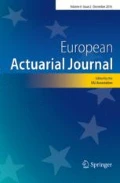Abstract
Various stochastic models have been proposed to estimate mortality rates. In this paper we illustrate how machine learning techniques allow us to analyze the quality of such mortality models. In addition, we present how these techniques can be used for differentiating the different causes of death in mortality modeling.




Similar content being viewed by others
References
Alai DH, Arnold S, Sherris M (2015) Modelling cause-of-death mortality and the impact of cause-elimination. Ann Actuar Sci 9(1):167–186
Breiman L, Friedman J, Olshen RA, Stone CJ (1984) Classification and regression trees. Wadsworth Statistics/Probability Series, Chapman and Hall/CRC, Boca Raton
Cairns AJG, Blake D, Dowd K, Coughlan GD, Epstein D, Ong A, Balevich I (2009) A quantitative comparison of stochastic mortality models using data from England and Wales and the United States. N Am Actuar J 13(1):1–35
Hirz J, Schmock U, Shevchenko P (2017) Actuarial Applications and Estimation of extended CreditRisk+. Risks 5(2):23
Lee RD, Carter LR (1992) Modeling and forecasting U.S. mortality. J Am Stat Assoc 87(419):659–671
Renshaw AE, Haberman S (2003) Lee–Carter mortality forecasting: a parallel generalized linear modelling approach for England and Wales mortality projections. J R Stat Soc Ser C (Appl Stat) 52(1):119–137
Renshaw AE, Haberman S (2006) A cohort-based extension to the Lee–Carter model for mortality reduction factors. Insur Math Econ 38(3):556–570
Richards SJ (2009) Selected issues in modelling mortality by cause and in small populations. Br Actuar J 15(supplement):267–283
Stommel H, Stommel E (1983) Volcano weather: the story of 1816, the year without a summer. Seven Seas Press, Newport
Therneau TM, Atkinson EJ (2015) An introduction to recursive partitioning using the RPART routines. R Vignettes. Mayo Foundation, Rochester
Villegas AM, Millossovich P, Kaishev V (2016) StMoMo: an R package for stochastic mortality modelling. R Vignettes
Wüthrich MV (2016) Non-life insurance: mathematics & statistics. https://ssrn.com/abstract=2319328
Wüthrich MV, Buser C (2016) Data analytics for non-life insurance pricing. https://ssrn.com/abstract=2870308
Author information
Authors and Affiliations
Corresponding author
Appendix
Appendix
1.1 Figures on Swiss cause-of-death mortality
The odd rows illustrate the regression tree estimated probabilities \(\theta ^ {\rm tree}(k| {\varvec{x}})\) for females. These plots all have the same scale given in the middle plot in each odd row. The even rows show the corresponding Pearson’s residuals given by (8). These plots all have the same scale given in the middle plot in each even row
The odd rows illustrate the regression tree estimated probabilities \(\theta ^ {\rm tree}(k| {\varvec{x}})\) for males. These plots all have the same scale given in the middle plot in each odd row. The even rows show the corresponding Pearson’s residuals given by (8). These plots all have the same scale given in the middle plot in each even row
Rights and permissions
About this article
Cite this article
Deprez, P., Shevchenko, P.V. & Wüthrich, M.V. Machine learning techniques for mortality modeling. Eur. Actuar. J. 7, 337–352 (2017). https://doi.org/10.1007/s13385-017-0152-4
Received:
Accepted:
Published:
Issue Date:
DOI: https://doi.org/10.1007/s13385-017-0152-4








